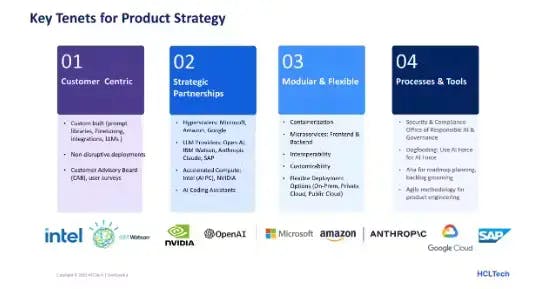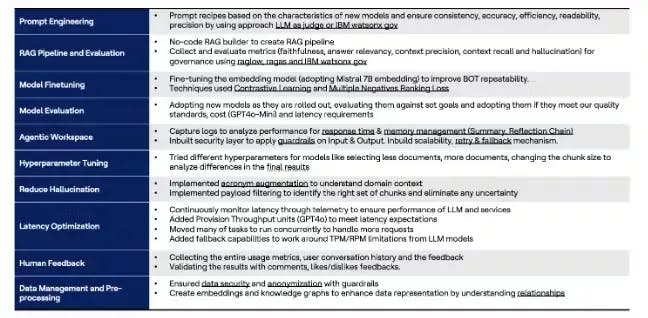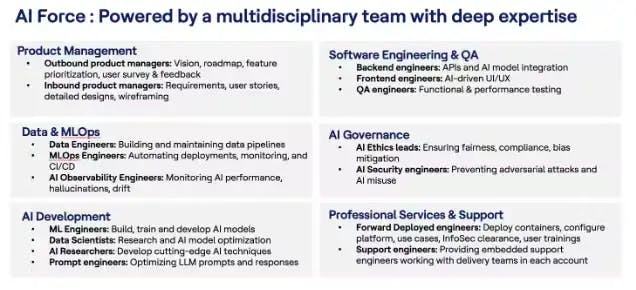What is AI Force?
HCLTech AI Force is a dynamic suite of GenAI-powered solutions designed to inject intelligence, drive efficiencies and support every aspect of the software engineering and IT operations lifecycles. From software development to support and maintenance, our AI-driven approach reshapes processes for maximum efficiency. It also prioritizes Responsible AI adoption, integrating robust security and governance measures to foster secure innovation and growth at scale.
- AI Force for Developers elevates product development efficiency through intelligent engineering, enhancing product experience and driving seamless development.
- AI Force for Testers redefines preventive quality assurance by seamlessly automating testing procedures, pinpointing defects, tracking progress and optimizing testing cycles to bolster the reliability and security of your applications.
- AI Force for Support leverages proactive care to swiftly resolve incidents and provide tailored solutions, ensuring smoother operations and improved client satisfaction.
How was AI Force developed, and what is the road ahead?
Our Ideation and Enhancement Request process includes:
- Aha tool to capture all ideas and enhancement requests
- Self-service tool open to delivery team members and other internal stakeholders
- Prioritization framework to generate a score for each idea/enhancement
- Customer Advisory Board (CAB) to capture client feedback
Our Roadmap and Release Planning strategy includes:
- Joint governance council to evaluate ideas and enhancements across various AI Force modules (SDLC, Operations, Business Process Automation)
- Quarterly release commitment and sign-off process
- Major, minor, and hot fixes release cadence
- User survey during and post-deployment to capture areas of improvement
- Customer feedback on Aha, CAB, Customer 360 for customer advocacy
We recommend five CoEs to enable product teams:
- Release Management
- Legal and Compliance, Accessibility
- GenAI Adoption
- Testing (security, vulnerability, performance, penetration)
- UX (for standardization of user experience)
Additional information on our product management processes and tools can be found in the images below:

AI Force Platform Best Practices


What are some examples of client use cases that AI Force effectively addresses?
AI Force excels with practical, AI-driven use cases tailored to different personas and activities, enhancing the sophistication and efficiency of various tasks. It offers a range of functionalities that cater to all stages of the software engineering lifecycle, ensuring smoother workflows and better outcomes.
- AI Force for Developer use cases
- Code summarization: Explain existing code and its purpose
- Code refactoring: Optimize existing code without changing its behavior
- Security assessment: Identifying and fixing code and licensing vulnerabilities
- Change impact analysis: Analyzing the new feature's impact on existing project artifacts
- Unit test generation: Generating unit test cases
- Code clone detection: Locating similar pieces of code for better maintainability
- Code generation: Generating code based on functional requirements
- SQL generation: Generating SQL queries from natural language
- SQL summarization: Explain database schemas such as tables, columns, etc.
- Testers
- Test case/script generation: Generating test cases and scripts from product requirements
- Duplicate defect detection: Identifying duplicate bugs
- Test case grouping: Identifying and clustering similar test cases
- Test case/script optimization: Optimizing the existing suite of test cases/scripts
- Test case recommendation: Recommending test cases against a defect, code change or new feature addition
- Support
- Best solutions recommendation
- Diagnostic questionnaire: Generating diagnostic questions to understand context, based on which it then generates the best recommended action for the specific problem
- Knowledge article creation: Leveraging GenAI to generate knowledge base articles
- Similar ticket identification: Identifying tickets with similar issues
- Q&A-based troubleshooting: Generating troubleshooting procedures
- Intelligent ticket routing: Assigning a problem based on historical data
- Cognitive search: Providing highly relevant and personalized search results across structured and unstructured data
Accelerate innovation in IT and business with AI Force.
Why would I want to use AI Force if I can access GitHub Copilot (or other similar tools)?
First, context length is crucial: GitHub Copilot, powered by OpenAI Codex, has a context length of 4,000 tokens, allowing for substantial code analysis. In contrast, AI Force lets users choose from different language models with potentially varying context lengths, which could accommodate more complex tasks.
Integration is another notable aspect. While GitHub Copilot is designed to work seamlessly with VS Code, AI Force offers plugins for various IDEs, including Eclipse and VS Code, providing flexibility across platforms.
Both tools are concerned about security. GitHub Copilot lacks robust input-level security measures, whereas AI Force specifies that it won't consume MEND-type reports, indicating a more proactive stance on security.
In summary, while both AI Force and GitHub Copilot enhance coding with AI, their context management, integration capabilities and security approaches present important distinctions for developers to consider.
Which AI Force features make it unique compared to other commercially available tools?
Comprehensive SDLC coverage
AI Force is designed to support the entire software development lifecycle, from requirements gathering to post-production support. This includes requirement generation, user story creation, code development, testing, deployment and maintenance. Many other tools focus on one specific stage rather than the entire lifecycle.
Integration with multiple tools and data sources
AI Force can integrate with a wide range of tools and data sources, such as Jira, spreadsheets, source code repositories and content management systems. This allows it to gather and analyze data from various stages of the SDLC, providing a holistic view of the development process.
Advanced AI and ML capabilities
The platform leverages both traditional AI/ML models and large language models (LLMs) from leading providers like OpenAI, Google, Meta, IBM and AWS. This versatility allows AI Force to apply the most suitable AI techniques to each different task, enhancing its effectiveness.
Customization and extensibility
AI Force offers extensive customization options, allowing users to tailor the platform to their unique needs. It also supports the creation of custom connectors and the development of new use cases on top of the existing platform, making it highly adaptable to various business requirements.
Embedded and standalone modes
Users can use AI Force as a standalone platform or embed its capabilities within their existing tools and environments, including integration with IDEs like Visual Studio and JetBrains.
Responsible AI and security
The platform includes features for Responsible AI usage, such as data anonymization and security configurations to protect sensitive information. This focus on ethical AI practices sets it apart from many other tools.
Ontology and relationship discovery
AI Force can discover and map relationships between data sets, such as requirements, code, test artifacts and defects. This capability helps create a comprehensive view of the development process and enhances the platform's ability to perform root cause analysis and optimization.
Change impact analysis
It takes care of requirement deviations and helps users understand how new requirements will impact downstream activities.
FinOps reporting
Its FinOps-related reporting capabilities include sales, geo-based revenue/sales, impacted code and more.
What is the AI Force data backup and retention policy?
AI Force provides clients with complete control over their data retention. The duration for which data is stored within the platform is determined solely by each client's specific requirements. HCLTech's professional services team will help implement these requirements and policies on a case-by-case basis.
Additionally, the platform supports dynamic data management based on use case needs. As business logic evolves, stale data irrelevant to current operations can be efficiently removed from the system.
This flexibility gives clients the power to optimize their data storage and management strategies in alignment with business objectives.

